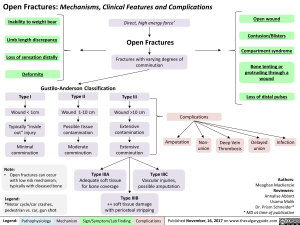Open Fractures: Mechanisms, Clinical Features and Complications
Inability to weight bear
Limb length discrepancy
•
Loss of sensation distally
Deformity
Gustilo-Anderson Classification
Type I
Wound < 1cm
Typically "inside
out" injury
Yir
Minimal
comminution
Type II
Wound 1-10 cm
4,
Possible tissue
contamination
Moderate
comminution
Note:
• Open fractures can occur
with low risk mechanism,
typically with diseased bone
Legend:
*Motor cycle/car crashes,
pedestrian vs. car, gun shot
Direct, high energy force*
Open Fractures
Fractures with varying degrees of
comminution
Type Ill
Yir
Wound >10 cm
4,
Extensive
contamination
Extensive
comminution
Type IIIA
Adequate soft tissue
for bone coverage
Legend: Pathophysiology Mechanism
Complications
Open wound
Contusion/Blisters
Compartment syndrome
Bone tenting or
protruding through a
wound
Loss of distal pulses
Amputation
Type IIIC
Vascular injuries,
possible amputation
•
Type IIIB
++ soft tissue damage
with periosteal stripping
Sign/Symptom/Lab Finding
Non-
union
Deep Vein
Thrombosis
Delayed
union
Infection
Authors:
Meaghan MacKenzie
Reviewers:
Annalise Abbott
Usama Malik
Dr. Prism Schneider*
* MD at time of publication
Foundations
Systems
Other Languages
Orthopedics Trauma Open Fractures: Mechanisms, Clinical Features and Complications Open Fractures: Mechanisms, Clinical Features and Complications

